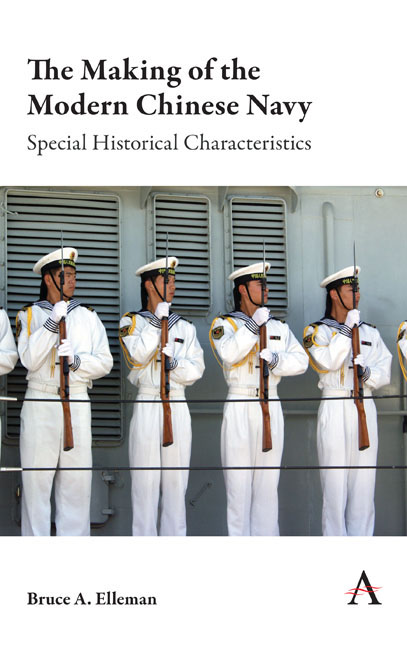Book contents
- Frontmatter
- Contents
- Introduction: The Special Characteristics of China's Maritime History
- 1 Battle of Bạch Đăng River (938)
- 2 Battle of Yaishan (1279)
- 3 Battle of Lake Poyang (1363)
- 4 Ming–Kotte War in Southeast Asia (1410–11)
- 5 Ming Loyalists Flee to Taiwan (1661–83)
- 6 Battle of Chuanbi (1839)
- 7 Sino-French War (1884–85)
- 8 Qing Beiyang Fleet's Defeat in the Battle of the Yellow Sea (1894)
- 9 Chinese Decision to Sink The Nationalist Navy as Blockships (1937)
- 10 Chongqing Mutiny Allowing the PLA to Cross the Yangzi River (1949)
- 11 The Taiwan Strait Crises (1954–55 and 1958)
- 12 China's Decision to Take the Paracel Islands from South Vietnam (1974)
- 13 Missile Blockade: The Taiwan Strait Crisis (1995–96)
- 14 The EP-3 Standoff and Diplomatic Resolution (2001)
- Conclusions: The Influence of History on the Formation of a Modern Chinese Navy
- Selected Bibliography
- Index
2 - Battle of Yaishan (1279)
Published online by Cambridge University Press: 04 October 2019
- Frontmatter
- Contents
- Introduction: The Special Characteristics of China's Maritime History
- 1 Battle of Bạch Đăng River (938)
- 2 Battle of Yaishan (1279)
- 3 Battle of Lake Poyang (1363)
- 4 Ming–Kotte War in Southeast Asia (1410–11)
- 5 Ming Loyalists Flee to Taiwan (1661–83)
- 6 Battle of Chuanbi (1839)
- 7 Sino-French War (1884–85)
- 8 Qing Beiyang Fleet's Defeat in the Battle of the Yellow Sea (1894)
- 9 Chinese Decision to Sink The Nationalist Navy as Blockships (1937)
- 10 Chongqing Mutiny Allowing the PLA to Cross the Yangzi River (1949)
- 11 The Taiwan Strait Crises (1954–55 and 1958)
- 12 China's Decision to Take the Paracel Islands from South Vietnam (1974)
- 13 Missile Blockade: The Taiwan Strait Crisis (1995–96)
- 14 The EP-3 Standoff and Diplomatic Resolution (2001)
- Conclusions: The Influence of History on the Formation of a Modern Chinese Navy
- Selected Bibliography
- Index
Summary
The Mandate of Heaven switches from dynasty to dynasty. This transition is often accomplished by civil war. For example, the last remnants of the Song loyalists lost to the Mongols at the Battle of Yaishan on March 19, 1279. Interestingly, both fleets were composed mainly of Han Chinese, and the two Han commanders were born in the same region of North China, shared the same surname, and even belonged to the same clan. The Song supporters hoped to recreate their dynasty while those Han Chinese who fought for the Mongols supported the new Yuan dynasty. After the Yuan victory at Yaishan the Mongols acquired an additional 800 Song ships. As one specialist of the Yuan navy has concluded, it was “essentially the Song navy” fighting itself on both sides of the battle, and that “except for a few thousand Mongols, the Yuan forces that fought at the historic battle of Yaishan were all Han Chinese.”
Summary of the Battle of Yaishan
In the first fifty years of the Mongol continental expansion, their armies raided throughout North China, and invaded Russia, Poland, Silesia, Moravia, Hungary, and eastern Austria, eventually pushing south into Asia Minor. But they made little progress against the maritime states of East Asia. For example, for 30 years they were unable to cross the Imjin River to take the island of Kangwha where the Korean king had fled. For 40 years the Mongols maneuvered their forces around the northern and western borders of the Southern Song empire, but they were unable to break through the Chinese defensive system between the Huai River and the Yangzi River. All of this changed once Han Chinese defectors knowledgeable about maritime warfare joined the Mongols.
Previously, the Mongols had had little use for boats in their land campaigns. But in 1259, Qubilai Khan promoted Zhang Rongshi to be “Commander of Ten Thousand of the Navy” with the specific goal of training naval officers. In 1265, Qubilai moved his capital to Yanjing, in northern China, and began creating his great capital, Daidu, on the site of modern-day Beijing. Mongol military preparations against the Song included building a navy to penetrate into the waterways of the Chinese defensive system. But despite years of effort, the newly created Yuan navy failed to break through the Song defenses.
- Type
- Chapter
- Information
- The Making of the Modern Chinese NavySpecial Historical Characteristics, pp. 11 - 16Publisher: Anthem PressPrint publication year: 2019



